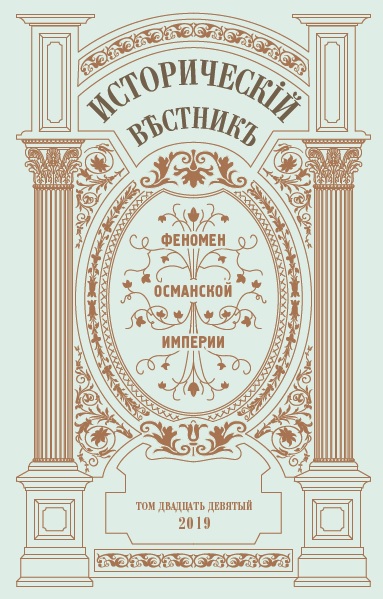
Абидулин А.М., Ширкина И.А. Трансформация идеологических концепций в Османской империи в 1850–1900 гг. Османизм-панисламизм
DOI: 10.35549/HR.2019.2019.47859А.М. Абидулин, И.А. Ширкина. Трансформация идеологических концепций в Османской империи в 1850–1900 гг. Османизм-панисламизм // Исторический вестник. 2019. Т. ХXIХ. С. 196—215.
Аннотация
Статья посвящена анализу идеологических концепций в Османской империи во второй половине XIX - начале XX века. Изучение генезиса терминов «османизм» и «панисламизм» позволяет нам отметить их западное происхождение и трактовать их в качестве идеологии сохранения империи и исламского единства, а также как стремление к культурному объединению всех мусульман, признающих духовную власть османского султана. В рамках изучаемого периода панисламизм рассматривается в тесной связи с предшествующей ему идеологической концепцией османизма. Показаны векторы, в которых панисламизм использовался как инструмент государственной политики в период правления султана Абдул-Хамида II. Нами также исследуется процесс трансформации идеологических концепций позднего периода Османской империи. Показано, что концепции османизма и панисламизма соответствовали требованиям своего времени, учитывая политические и демографические обстоятельства, при этом не взаимозаменяя, а сосуществуя в тесной связи друг с другом.
Ключевые слова: Османская империя, государственные идеологии, османизм, панисламизм, султан Абдул-Хамид II.
***
A.M. Abidulin, I.A. Shirkina. Transformation of Ideological Concepts in the Ottoman Empire in 1850–1900. Ottomanism-Pan-Islamism [Transformaciya ideologicheskih koncepcij v Osmanskoj imperii v 1850–1900 gg. Osmanizm-panislamizm]. Istoricheskij vestnik / Historical Reporter. Vol. 29. 2019. P. 196—215.
Abstract
The article is devoted to the analysis of ideological concepts in the Ottoman Empire in the second half of the XIX — early XX centuries. Studying the genesis of the terms «Ottomanism» and «Pan-Islamism» allows us to note their Western origin and treat them as an ideology of preserving the empire and Islamic unity, as well as a desire for the cultural unification of all Muslims who recognize the spiritual power of the Ottoman Sultan. Within the framework of the period under study, pan-Islamism is considered in close connection with the ideological concept of Ottomanism preceding it. The vectors in which pan-Islamism was used as an instrument of state policy during the reign of Sultan Abdul-Hamid II are shown. We also study the process of transformation of ideological concepts of the late period of the Ottoman Empire. It is shown that the concepts of Ottomanism and Pan-Islamism met the requirements of their time, given the political and demographic circumstances, while not interchangeably, but coexisting in close connection with each other.
Keywords: Ottoman Empire, State Ideologies, Ottomanism, Pan-Islamism, Sultan Abdul-Hamid II.
***
References
- Bury G.W. Pan-Islam. London, 1919.
- Deringil S. The Ottoman Response to the Egyptian Crisis of 1881–82 // Middle Eastern Studies. 1988. Vol. 24. No. 1. Р. 3–24.
- Deutsch K. Nationalism and Its Alternatives. N.Y.: Alfred A. Knopf, 1969.
- Devereux R. The First Ottoman Constitutional Period.Baltimore. The Johns Hopkins Press, 1963.
- Fadeeva I.L. Official doctrines in the ideology and politics of the Ottoman Empire (Ottomanism-Pan-Islamism) XIX — beginning of XX century: avtoref. dis. na soisk. uchen. step. d. i. n.: 07.00.03 / Fadeeva Irma L’vovna. Moscow, 1989.
- Gelner E. Nations and Nationalism. Moscow, 1991.
- Gramsci A.The Prison Notebooks. Moscow, 1991.
- Hocaoğlu M. II Abdulhamid Han’ın Muhtıralı. Istanbul. Kamer Yayınları, 1998.
- Karpat K. The Transformation of the Ottoman State, 1789–1908 // International Journal of Middle East Studies. 1972. Vol. 3. No. 3. P. 243–281.
- Kemal K. The Ottoman Parliament of 1877 and Its Social Significance // Actes du premier congres international des etudes Balkaniques, IV. Sofia,1969. Р. 247–257.
- Landau J.M. Al-Afgani’s Pan-Islamic Project // Islamic Culture. 1952. № 37.
- Landau J.M. The Politics of Pan-Islam: Ideology and Organization. Clarendon Press, New York: Oxford University Press, 1990.
- Lee D. The Origins of Pan-Islamism // The American Historical Review. 1942. Vol. 47. No. 2. P. 278–287.
- Lenin V.I. The right of nations to self-determination / Lenin V.I. Polnoe sobranie sochinenij. M.: Izdatel’stvo politicheskoj literatury, 1969. T. 25.
- Mehmed Cavid Bey. İktisat İlmi. Ankara. Liberte Yayınları, 2001.
- Petrosjan Ju.A. Muslim clergy and reforms in the Ottoman Empire in the 19th century // Narody Aziii Afriki. 1983. № 2. S. 106–110.
- Petrosjan Ju.A. New Ottomans and the struggle for the constitution of 1876 in Turkey. Moscow, 1958.
- Petrosjan Ju.A. Turkish journalism of the era of reforms in the Ottoman Empire (late XVIII — early XX century). Moscow, 1985.
- S. Tufan Buzpınar. Abdulhamid II, Islam and the Arabs: The Cases of Syria and the Hijaz (1878–1882) / S. Tufan Buzpınar. University of Manchester, 1991.
- Stoddard L. New World of Islam / Lothrop Stoddard. N. Y., 1921.
- The Ottoman Constitution, Promulgated the 7thZilbndje, 1293 (11/23 December, 1876) // The American Journal of International Law. 1908. Vol. 2. No 4.
- Yusuf Akcura. Osmanlı Devleti’nin Dagılma Devri (18 ve 19 asirlarda). Ankara. Turk Tarih Kurumu, 1988.
- Yusuf Akcura. UcTarz-ı Siyaset. Ankara. Alternatif Yayınları, 2002.
- Zheltjakov A.D. Printing in the socio-political and cultural life of Turkey. Moscow: Nauka, 1972.
